This is your new blog post. Click here and start typing, or drag in elements from the top bar.

This acrylic painting is an abstract picture of two white flowers in full bloom, and the third flower as a young undeveloped bud.
After completing this project I have learned a very important lesson. Your art does not have to be a true representation of the real deal. I also learned that it is very important to stack on the paint to get some movement through the piece without it looking dry and scratchy.
In this piece I was not afraid to make this piece my own. The little swirls and blotches of color in the corners are supposed to be the background as the dirt and debris on the ground.
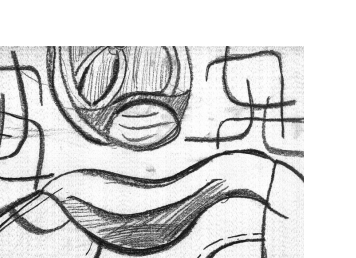
This is an abstract drawing of a pair of shoes from two different angles. One shoe is facing so only the backside is visible, while the other is placed at the side but so only most of the side view top half is showing.
What makes this drawing abstract from the first sketch of ordinary shoes ( blog below) is that in the background there are various lies over laping one another. These lines represent the mass or space taken up by the unvisible air that surrounds these objects. This drawing is also abstract in that I tried to elongate the front shoe just as Dali did with his famous painting of the clocks beginning to melt as the eye travels through he painting to represent the slowingdown or, dissipperarence of time altogether.
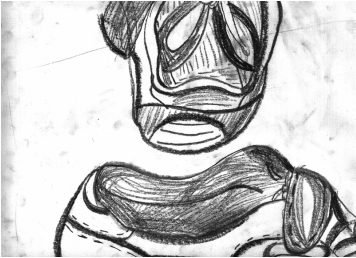
This sketch is of an ordinary pair of sneakers from two different angles. One shoe is positioned so that only the back side is visible and the other is placed so the whole side of the shoe can be seen eventhough there is only a sideways view of mainly the top half of the shoe.
After doing this drawing I learned about the importance of the thickness and thiness of lines when drawing an object to create the illusion of the subject turning in space and it also gives the peice some dimension.
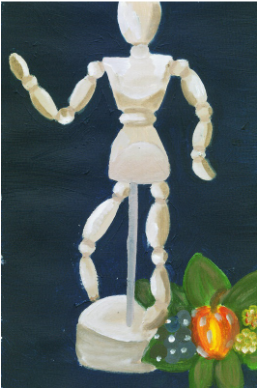
This still life acrylic painting is of a wooden manikin standing in the center of my painting with fake leaves; blueberry’s and flowers in the lower right hand corner. This painting looks very photorealist to me.
The highlights and shadows on the manikin give him a real wooden feel with the way the light reflects off the wood and also the angling of the light. Because the assortment of fruit and leaves were fake, they had a real shine on them and I feel that I portrayed all of the little shiny spots that were on the apple and other blueberries. Also the leaves in the painting have several shades of green brown and a hint of yellow. Also the blueberries are various shades of blue which reflect the various angling of the light.
I choose such a dark blue background for this painting because I really wanted my wooden manikin and floral bouquet to stand out; which to me I accomplished just that.
My initial reaction to this painting is WHOA! The manikin is the first thing that stands out because it is so bright and light. And then my eye is drawn to the apple and flowers because they are the only subjects in the whole painging with some real colors besides beige and green.
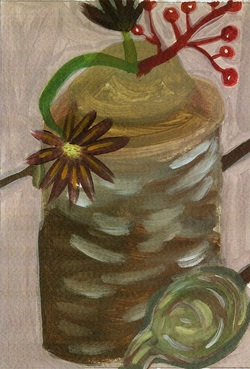
This still life acrylic painting is of a tall and slender metal cylinder with a cone shape top, two old and faded flowers, a mini green gourd and some plastic cranberries. Again I first painted the general shapes and then moved to the specific highlights.
What I learned through this lesson was that I should first begin to paint the general shapes of the subjects before moving to the specifics.
My reaction to this painting is that it is very dark and seems to be aged. Both of the flowers have no real bright vivid colors that pop out. Also the flower in the back seems dead and dry. Also my gourd in the front of my painting has no other colors besides various shades of green, some white, and a little brown and red.
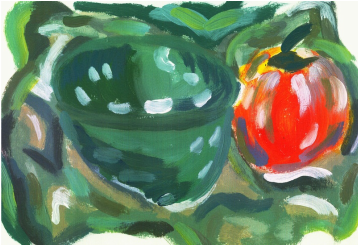
This still life acrylic painting is of a shallow and short green ceramic vase, and a red/ orange apple on a cleaning cloth. This still life has some depth in the sense that not every square inch of the painting is covered in detail.
This painting was painted by first painting the large general shapes with the background at the same time and then moving to the more specific highlights and other details.
This still life sketch is of a somewhat short, stout pot, a hammer and a copper cylinder main body shape with a spout in the front center and a cone at the cylinder’s top. The way each item in this sketch is staggered and the way the pieces themselves are layered, give this piece a real three - dimensional look and feel. Which gives the illusion of a simulated texture.
The shading lines are very bold and range in value. They are especially noticeable on the pot, which makes it look like the pot is actually round due to the darker edges and gradual lightness to the pot’s center. As well as the strong dark horizontal streaks across the body.
The various shapes sizes of the pieces use in this sketch help to give it some interest. On the right side there is a large roundly stout object, and on the left there is a tall horizontally light, and slender object. In the middle of these two broad and various pieces, rests a hammer on the pot’s rim to break up the stoutness and height difference of these two objects. Like the pot, the hammer adds some curves in the lines of the shapes. Especially in the hammers head and handle bar. The various heights of this piece also give the piece interest as the eye moves up, down and horizontal.
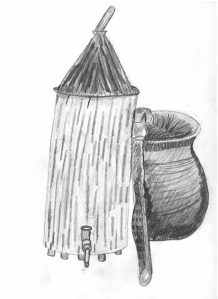
This is a water color painting of an apple overlapping (in front of) a small, miniature pumpkin. This is my second classroom blog posted since using the watercolors. My first blog using the watercolors was just a painting of a plain apple. After viewing the watercolor tutorial, I have learned many dos, and don’ts.
The first thing that I realized after the tutorial was that in my plain apple watercolor painting, the apple is floating around in the abyss of space. Secondly that there are no white spots in the painting to give the painting or objects depth. Therefor the apple has no light and if there are no light spots then the apple appears to be a flat circle instead of a round three- dimensional object. Lastly, the paint on the first apple is too dry which therefor allows no blending of colors to give the apple a realistic look.
In this most recent painting of an apple overlapping a minuscule pumpkin, there are all these important tutorial concepts in the painting. The colors ran, there are a few more visible outlined spots to give the appearance of spin on both objects, white spots to give a three- dimensional look and show there is some depth and the appearance that the objects have a slight bulge outward.
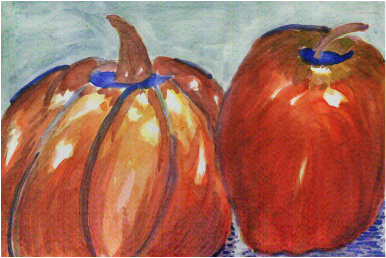

This piece is a watercolor painting of a reddish, yellow- orange stem less apple strategically placed on a wooden table.
This is your new blog post. Click here and start typing, or drag in elements from the top bar.

This still life value drawing is of an apple (central object), a blueberry (placed in the upper left hand corner), three little flowers (in the lower right hand corner), and placed in the lower left hand corner is a chestnut.
It is visibly clear to see the different values throughout this sketch. For instance. The the apple’s center has a visibly noticeable white spot where the light hit the apple as well as the darker outline, giving it a rounded and dimensional look.
This is your new blog post. Click here and start typing, or drag in elements from the top bar.










 RSS Feed
RSS Feed